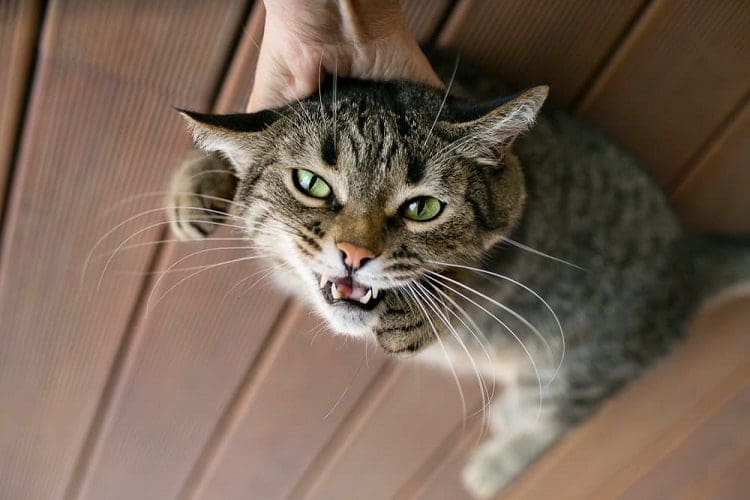Last Updated: 11 months ago
Learning how to discipline a cat is a tricky task, but it’s an important part of being a responsible pet owner.
It’s essential to establish rules and stick to them, use positive reinforcement, be consistent, and never resort to physical punishment.
Understanding your cat’s body language is also key in how to discipline cats effectively.
With the right approach, you can help your cat learn appropriate behavior and create a harmonious home environment for both you and your furry friend.
#1 Establish Rules and Stick to Them

As a cat owner, it’s important to establish rules for your pet and stick to them. Doing so will help your cat understand what is expected of him or her, making it easier for you to train them in the long run.
When trying to discipline your cat, make sure your rules are clear and consistent. This means that everyone in the household should be aware of the same set of rules and should follow them at all times.
It also helps if you can provide rewards when your pet follows these guidelines as this reinforces positive cat behaviors.
It’s also important to remember that cats have different personalities and needs, so some may need more structure than others when it comes to cat discipline.
For example, some cats may respond better with verbal cues while others may require physical contact such as tapping on their shoulder or lightly pushing them away from an area where they shouldn’t be going.
If you find yourself getting frustrated with cat misbehavior, take a step back and try using positive reinforcement instead of punishment.
Rewarding good behaviors rather than punishing bad ones can go a long way towards helping build trust between each other!
Keep in mind that consistency is key in cat discipline. If you give mixed signals or change up the rules too often then this could confuse your pet which could lead to further behavioral issues down the line.
So make sure all your family members understand what is expected from both parties before implementing discipline methods!
Learning how to discipline a cat, establishing clear boundaries, and sticking to them will help ensure that both you and your furry friend have a happy relationship together.
#2 Use Positive Reinforcement

When learning how to discipline cats, positive reinforcement is the way to go. Positive reinforcement is a method of training that rewards desired behaviors with something pleasant like treats, petting, or verbal praise.
This type of reward-based training encourages your cat to repeat the behavior you want them to do and helps build trust between you and your feline friend.
Positive reinforcement can be used for all kinds of behaviors from teaching basic commands such as “sit” or “come” to more complex tricks like playing fetch or jumping through hoops.
It can also help reduce problem behaviors such as scratching furniture or urinating outside the litter box by rewarding good behavior instead of punishing cat misbehavior.
For example, place cat trees near their window perches. They’re more likely to use these scratching posts because of their location.
When they try to scratch furniture, gently remove them and place them near the tree and reward them for scratching it.
Using positive reinforcement will not only make training easier but also create a stronger bond between you and your cat.
Cats are intelligent creatures who thrive on structure and consistency so having clear expectations in place will help keep them focused. It will also give them plenty of opportunities for success along the way!
It’s important to remember that when using positive reinforcement, timing is key. Rewards should be given immediately after a desired behavior has been displayed in order for your cat to associate their action with the reward they receive afterward.
Always use high-value treats (like tuna flakes) when rewarding good behavior since these types of treats are more likely to motivate your kitty than regular dry food.
Don’t forget about verbal praise. Cats love hearing kind words just as much as receiving tasty snacks!
Overall, using positive reinforcement when disciplining cats is an effective way to train our furry friends without causing any stress or anxiety.
Not only does this type of reward-based system provide quick results but it also strengthens the bond between owner and pet which makes both parties happy in the end!
#3 Be Consistent

Establishing cat discipline can be a difficult and time-consuming task, but it doesn’t have to be. One of the most important things you can do when learning how to discipline cats is to be consistent.
This means establishing rules and sticking to them – no matter what! If you allow your cat to jump on the counter one day, but not the next, they will get confused and won’t know what is expected of them.
Being consistent with commands, rewards, and punishments will help make sure that your cat understands exactly what behavior is acceptable or unacceptable in any given situation.
Think about it this way: if someone was constantly changing their mind about something every single day without warning or explanation, how would you feel?
You’d probably feel frustrated and confused. Just like cats do when we’re inconsistent with our expectations for them! That’s why consistency is key when it comes to training cats.
Consistency also helps create trust between you and your pet.
If they know that they can count on you to provide clear instructions each time (and follow through with those instructions), then they’ll start feeling more secure in their environment which leads to better overall behavior from them as well.
So remember: if you want successful results with your discipline methods – stay consistent!
Establish rules that are easy for both of you to understand (like always using the same command word) and stick with those rules no matter what happens during the process so that everyone involved knows exactly where they stand at all times.
#4 Don’t Use Physical Punishment

As pet parents, we all want our cats to behave in a way that is safe and comfortable for both them and us.
Unfortunately, physical punishment can be an easy go-to solution when trying to figure out how to discipline a cat.
However, this type of punishment is not only ineffective but can also lead to more behavioral issues down the line.
Physical punishment involves any form of physical contact that causes pain or discomfort such as hitting, slapping, pinching or shaking your cat.
This kind of treatment has been proven to have negative effects on cats’ mental health and behavior. It can cause fear and aggression towards humans, which leads to owner avoidance.
This will make training even harder in the long run. Additionally, it could potentially lead to medical problems if done too harshly or frequently enough over time.
So what should you do instead?
Positive reinforcement techniques are much more effective than physical punishment when disciplining your cat! These methods involve rewarding good behaviors with treats or praise rather than punishing bad ones with pain or discomfort.
By doing this consistently over time you will help build trust between you and your pet while teaching them how they should act around people and other animals in their environment.
At the end of the day, remember that cats are creatures of habit so consistency is key when using positive reinforcement techniques!
It may take some patience but by sticking with these methods you will eventually see results without having to resort to harsh punishments like physical abuse. Something no one wants for their beloved feline friend!
#5 Understand Your Cat’s Body Language

When it comes to understanding cats, body language is key. Cats are incredibly expressive creatures and they use their bodies to communicate with us in a variety of ways.
From the tilt of their ears to the position of their tail, cats have an entire vocabulary that we can learn if we pay attention. One way cats express themselves is through ear positioning.
If your cat’s ears are pointing forward, this usually means they’re alert and interested in something going on around them.
On the other hand, if your cat’s ears are flattened against its head or pulled back slightly, this could be a sign that it feels threatened or scared by something nearby.
Another way cats communicate is through eye contact – when your cat looks directly at you for more than two seconds without blinking or looking away, it typically means they trust you and feel comfortable with you being close by.
However, if your cat quickly averts its gaze after making eye contact with you then this could indicate fear or anxiety about something else in the environment (e.g., another pet).
Cats also use their tails as part of their communication repertoire; when a cat’s tail is held high and twitching from side to side rapidly this usually indicates excitement or playfulness while a low-hanging tail often signifies fearfulness or aggression towards something else nearby.
If your cat wraps its tail tightly around itself then this may mean that it’s feeling insecure about something happening in its environment. So take some time to investigate what might be causing such feelings before trying to interact further with them!
Posture can also tell us quite a bit about how our feline friends are feeling at any given moment. When relaxed and contented cats will often sit up straight with all four paws tucked underneath them.
Fearful felines may crouch down low while keeping an eye out for potential threats nearby. This behavior can also be seen during hunting activities.
By taking note of these subtle signs from our furry companions, we can better understand what they’re trying to tell us.
Whether it’s happiness over seeing us come home from work each day or distress due to loud noises outside–these signs ultimately help strengthen our bond together!
So next time you’re interacting with your kitty friend make sure to pay attention not only to what they say but also to how they say it. Even though words aren’t always necessary, sometimes just one look speaks volumes!
Final Word
You have now learned how to discipline cats the right way.
By establishing rules and sticking to them, using positive reinforcement, being consistent in your approach, avoiding physical punishment, and understanding your cat’s body language, you can help ensure that your cat is disciplined without causing any harm or distress.
Discipline cats with patience and kindness – they will thank you for it!
From understanding their behavior to implementing positive reinforcement techniques, we have all the information you need to ensure a happy and healthy relationship between you and your cats.
Resources:

Olfa knows how to get things done and has a keen business sense that others admire. She’s always on the go, coming up with new ideas! Her ability to anticipate the needs of her readers and deliver information that they want is what makes CatVills such a success. She loves cuddling her cat Picaciu. He is her inspiration.
